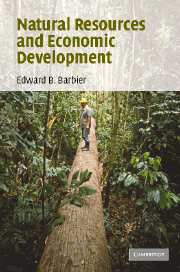Book contents
- Frontmatter
- Contents
- List of figures
- List of tables
- Acknowledgments
- Introduction
- 1 Natural resources and developing countries: an overview
- 2 Natural resource-based economic development in history
- 3 Does natural resource dependence hinder economic development?
- 4 Frontier expansion and economic development
- 5 Explaining land use change in developing countries
- 6 The economics of land conversion
- 7 Does water availability constrain economic development?
- 8 Rural poverty and resource degradation
- 9 Can frontier-based development be successful?
- 10 Policies for sustainable resource-based development in poor economies
- References
- Index
1 - Natural resources and developing countries: an overview
Published online by Cambridge University Press: 06 July 2010
- Frontmatter
- Contents
- List of figures
- List of tables
- Acknowledgments
- Introduction
- 1 Natural resources and developing countries: an overview
- 2 Natural resource-based economic development in history
- 3 Does natural resource dependence hinder economic development?
- 4 Frontier expansion and economic development
- 5 Explaining land use change in developing countries
- 6 The economics of land conversion
- 7 Does water availability constrain economic development?
- 8 Rural poverty and resource degradation
- 9 Can frontier-based development be successful?
- 10 Policies for sustainable resource-based development in poor economies
- References
- Index
Summary
Over the past twenty years, a major change has occurred in economic thinking. No longer do we consider the economic process of producing goods and services and generating human welfare to be solely dependent on the accumulation of physical and human capital. An increasing number of economists now accept that there is a third form of “capital” or “economic asset” that is also crucial to the functioning of the economic system of production, consumption and overall welfare. This distinct category consists of the natural and environmental resource endowment available to an economy, which is often referred to as natural capital.
Figure 1.1 depicts the basic relationship between physical, human and natural capital and the economic system.
Human-made, or physical, capital (KP), human capital (KH) and natural capital (KN) all contribute to human welfare through supporting the production of goods and services in the economic process. For example, KP, consists of machinery, equipment, factory buildings, tools and other investment goods that are used in production; KH includes the human skills necessary for advanced production processes and for research and development activities that lead to technical innovation; and KN is used for material and energy inputs into production, acts as a “sink” for waste emissions from the economic process, and provides a variety of “ecological services” to sustain production, such as nutrient recycling, watershed protection and catchment functions, habitat support and climate regulation.
- Type
- Chapter
- Information
- Natural Resources and Economic Development , pp. 11 - 50Publisher: Cambridge University PressPrint publication year: 2005



